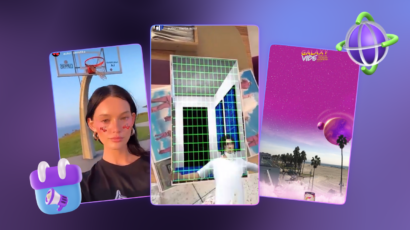Augmented Reality (AR) is sweeping the world. Augmented reality industry is constantly evolving, especially now that new companies are investing in various types of smart glasses. AR/VR smart glasses market trends showed that 93% of large industrial companies use smart glasses for their operations. Apple is rumored to be working on augmented reality projects. The news about launching the Apple Glasses in 2023, turned out to be quite resonant.
AR Glasses: What is it?
Augmented reality glasses are a completely different level of technological development. Something that excites everyone. Let’s discuss what exactly they are and how they work in reality.
AR glasses can project a digital overlay directly into a person’s field of vision without them needing to do anything. AR glasses have a wide range of functionality. Generally, the devices use a front-facing camera in concert with software that can recognize specific anchors and landmarks. AR glasses vary in shape, size, or design. The enhancement of reality with digital overlays is what they all have in common. Augmented reality glasses simply apply the technology to a wearable accessory. However, they are unique. The process of creating AR glasses can be divided into four steps: Initial image capture, scanning & anchoring, requesting data, and displaying information.
There are many reasons why people might want to augment their actual experiences. The trend is more apparent in the world of gaming.
AR VS VR: What’s the difference?
AR glasses are often confused with VR glasses, or AR glasses are mistaken for VR glasses. At first glance, augmented and virtual reality glasses may seem similar. The main difference between VR glasses and AR glasses is the degree to which reality is changed when viewed through them. While VR glasses completely isolate the user from the outside world, AR glasses overlay digital information over the user’s field of view to aid their real-world interactions. VR equipment is becoming increasingly immersive. Instead of glasses, VR is often delivered through a bulkier headset. In general, the equipment’s speakers stimulate the user’s auditory senses. There are cases when the equipment includes body coverings that provide touch stimulation.
AR glasses’ significant impact on major industries
The ability to augment the actual experience with useful information and data is a key factor driving demand for AR glasses. In the coming decades, the use of AR Glasses is expected to increase by 17.1 million units. AR smart glasses improve a user’s experience for domestic and professional use. Some of the major players in the AR glasses market are Lenovo, Samsung Electronics, Sony Group, Avegant Corp, Microsoft Corp., Alphabet Inc., etc.
The industrial sector is the largest consumer of these. These industries include electronics, engineering, automotive, aerospace, heavy machinery, and military. Meanwhile, the gaming, education, tourism, and healthcare sectors actively use AR glasses. Artillery Research’s expert market predicted the global market share for enterprise applications of AR glasses. It was predicted to be more than $35.2 billion. The primary beneficiaries of this industry are: Design (19%), Manufacture 18%, Market & Sell – 13%, Operate – 13%, Service – 17%, and Train – 17%.
Gaming
One of the best tools to use for gaming is Magic Leap One Glasses. The team had been working on it for about ten years before launching the first version of the glasses. When Google understood the power of these glasses, they invested in a project of about half a billion dollars. By wearing these glasses, you are able to mix fantasy life with real life. The Magic Leap 2 launched in September 2022 is way more advanced. The glass is easier to wear, more powerful, and offers a dramatically larger AR field of view.
Education
Augmented Reality, by introducing new methods of learning, provides enormous benefits not only to many students but also to teachers. AR glasses help students to better visualize the material and upgrade their photographic memory. The Glasses can show teachers important information about the students, their best and worst areas.
Healthcare
Do you have an idea how AR Glasses can be a beneficial tool for rehabilitation? AR Glasses are already used for making diagnoses and in therapy. Psychologists and computer scientists use AR to help treat phobias. The glasses help simulate the situation a patient is afraid of by gradually exposing them to the issue. They can interact with the object within the Augmented space and have a feeling of being there. Treatment of some phobias requires an approach, which is harder to achieve than others, and this is where AR Glasses come in handy.
The goal is to simulate the patient’s anxious environment and gradually present them with tasks to solve, ranging from simple to complex, until they feel secure in that environment. Patients become braver in simulated situations when they understand they are not real.
AR Glasses: Where are we now?
2023 is poised to be the year of AR glasses. Today’s applications are often in the form of HUDs or Head-up Displays. They are transparent displays that show data without distracting from the view – similar to a window with notes on it.
HUDs were originally developed for military aviation. The United States Army rolled out a $22bn program to develop mixed reality combat goggles, called the Integrated Visual Augmentation System (IVAS). The new goggles allow soldiers in combat to see and share data in real time, such as maps or enemy positions. Nowadays, HUDs are used in other industries, such as automobiles and commercial aircraft. HUDs are seen as the next step in pushing driver experience forward in cars, as they can display key information on a driver’s windshield, such as directions, without taking the driver’s eyes off the road. This type of AR HUD is already being used by car manufacturers such as Kia, which includes it in models such as the Kia EV6, Kia Niro, and others.
Apple Glass
Apple is developing at least two AR projects that include an AR headset to be released in 2023. The brand has been working on smart AR glasses since at least early 2017. Rumors say that Apple’s smart glass will be as sleek and stylish as the technology inside allows. Their design will avoid the appearance of ‘’heavy machinery on your face”. Apple Glasses could run on a proprietary operating system of IOS 13. Do you like the name glassOS? The AR framework appears several times in code and text documents, indicating that Apple is testing activation in some capacity.
A few days ago, Bloomberg reported that Apple Glasses are delayed again due to technical challenges in their development.
Lumus
Lumus’s private demos left many journalists impressed. A private presentation of its second-generation Z-lens 2D waveguide technology for AR glasses was held at CES. Lumus took prototype glasses that look a bit like standard glasses. The resolution is 2K x 2K per eye, allowing the wearer to read quite small text in front of him. Furthermore, the brightness, at 3000 nits, was able to not only provide very bright visuals but also allow people to use the display outdoors.
Lumus does not intend to manufacture glasses but is collaborating with partners who can. The company claims that it is possible to create very lightweight glasses, that have 50-80 degrees of FOV, and cost around $1000.
Google Glass Enterprise 2
With the launch of Google Glass in 2012, Google stands as one of the front-runners to commercialize AR glasses. Despite the high price tag, the brand pushed sales of Google AR glasses for the first 2000 pairs to be sold immediately.
Google Glass Enterprise 2 builds on Google’s early lead in AR. The headset is powered by the Android Open Source Platform. The headset provides glanceable and voice-activated control for accessing critical information for those who may have their hands full with other equipment. It can be used by a wide range of professional users. The headset’s 8MP camera streams clear video.
Nreal AR Glasses
A Beijing-based AR technology company has been developing mixed-reality wearables since 2017. Nreal has focused on creating AR wearables that are affordable and useful to the general public.
By transforming the on-the-go lifestyle, Nreal Air glasses offer users a new way to interact with their workspaces and favorite entertainment media. This is made possible by Nreal Air’s ability to provide an experience comparable to a 201-inch Imax screen while weighing only 79 grams. Nreal has also increased its efforts in recent years to be much more than an entertainment tool. Moreover, Nreal AR Glasses is a cheaper product compared to other brands’ Glasses which makes it more affordable.
What’s in the future: Growth of the AR Glasses market
Between 2023 and 2027, the global AR/VR smart glasses market is expected to grow by $7297.59M. It was worth $8.31 billion in 2019.
Significant factors positively influencing the AR/VR smart glasses market include rising industry 4.0 trends and rising demand for AR/VR technology in the gaming industry. However, the high costs of smart glasses and a lack of investment in AR/VR R&D are impeding the market growth. Furthermore, emerging trends toward 5G technologies and an increasing shift toward digitization are expected to provide lucrative opportunities for the growth of the AR/VR smart glasses industry in the coming years.
The skyrocketing market value is primarily due to the enormous popularity of these glasses. Furthermore, the widespread use of cloud-based technologies in BFSI, healthcare, manufacturing, retail, and IT & telecommunications increases market value.
Conclusion
Augmented reality glasses are going to be big. With each passing year, it appears that more comfortable and user-friendly AR glasses are on the horizon. Although they’re still relatively rare in commercial use, AR glasses have recently become a mainstay in manufacture, maintenance, and repair as a consequence of the industry 4.0 movement. There are plenty of reasons people might want to augment their actual experiences with helpful information and data. Market research shows that AR glasses are becoming more and more profitable. Unlike in the past, AR glasses are much more affordable and make life easier for people.
Unless you work in an environment where AR can help your production plans, you should just keep an eye on the technology.







